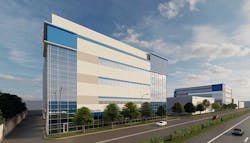Prime Data Centers continues to expand in the supply-constrained Silicon Valley market. The wholesale data center developer this week announced plans to build a four-story, 9-megawatt data center to provide future capacity in Santa Clara, the primary cloud hub in the region.
The 119,000 square-foot data center will be located at 1231 Comstock Street, and Prime will begin construction on the facility in the second half of 2023. The 1.9-acre site was previously a furniture store operated by Mark Thomas Home, but is surrounded by data centers operated by Digital Realty, as well as another Prime Data Centers facility at 1111 Comstock Street, a 9-megawatt data center which is under construction and has been fully leased by Cyxtera Technologies.
“We are excited to continue to expand our presence in Silicon Valley and the greater San Francisco Bay Area,” says Nicholas Laag, CEO of Prime Data Centers. “The region is as systemically important as ever and we’re seeing strong demand from the world’s most influential companies.”
Capital Enables Expansion in a Key Market
Prime is a privately-held developer based in Sacramento, where it is developing a campus at McClellan Park with room for up to six data center buildings. The company recently announced an 8-megawatt build-to-suit lease with a publicly-traded global enterprise, and now plans a second 8-megawatt data center at the campus.
Prime recently announced a strategic partnership with global infrastructure investor Macquarie, which plans targeted capital investments in excess of $5 billion over the next 10 years. Prime’s expansion in Silicon Valley illustrates how this type of investment creates new possibilities, allowing the developer to acquire properties for short-term growth as well as “land banking” for future growth.
This is no small matter, as Silicon Valley is one of the most difficult markets to bring new capacity to market. Santa Clara has long been the Data Center Capital of Silicon Valley due to competitive power pricing from the municipal utility, Silicon Valley Power. It’s the favored spot to deploy new hardware and services from the Valley’s marquee technology companies, as well as a legion of fast-moving startups. That’s why there’s 35 data centers are located in an 18-square mile municipality.
Several Phases of Growth Ahead
But Santa Clara has almost no open land parcels available, meaning developers must acquire sites with existing structures and knock them down to make way for a purpose-built data center. This approach, which is also becoming common in Northern Virginia, requires more time and investment than a “greenfield” build on clear land.
Prime’s strategy in Santa Clara allows it to bring new capacity to market in phases over time, starting with 1111 Comstock later this year, and 1231 Comstock in 2023. In addition to the two data centers in development on Comstock Street, Prime has also acquired several properties a mile away on Martin Street. The 2175 Martin project will be a 9-megawatt facility, with development getting underway now. Prime also plans a larger 32-megawatt data center on an adjacent site at 2225 Martin, which is occupied by a tenant but will be developed in 2025 as a three-story, 207,000 square foot facility.
Although Santa Clara is a challenging market, it is also busy and competitive, as many of the leading data center developers in expansion mode. NTT Global Data Centers Americas has just opened a new data center in Santa Clara, while Cologix recently entered the region with the acquisition of the vXchange Santa Clara site. Elsewhere in Santa Clara, Digital Realty has announced a major new project, while Vantage Data Centers continues to build out its newest campus.
Meanwhile, land prices continue to rise. Earlier this month, an Amazon subsidiary acquired a seven-acre site in Santa Clara for $51.8 million – more than $7 million per acre – for a future data center, while a transaction last year valued data center real estate at about $6 million an acre.






